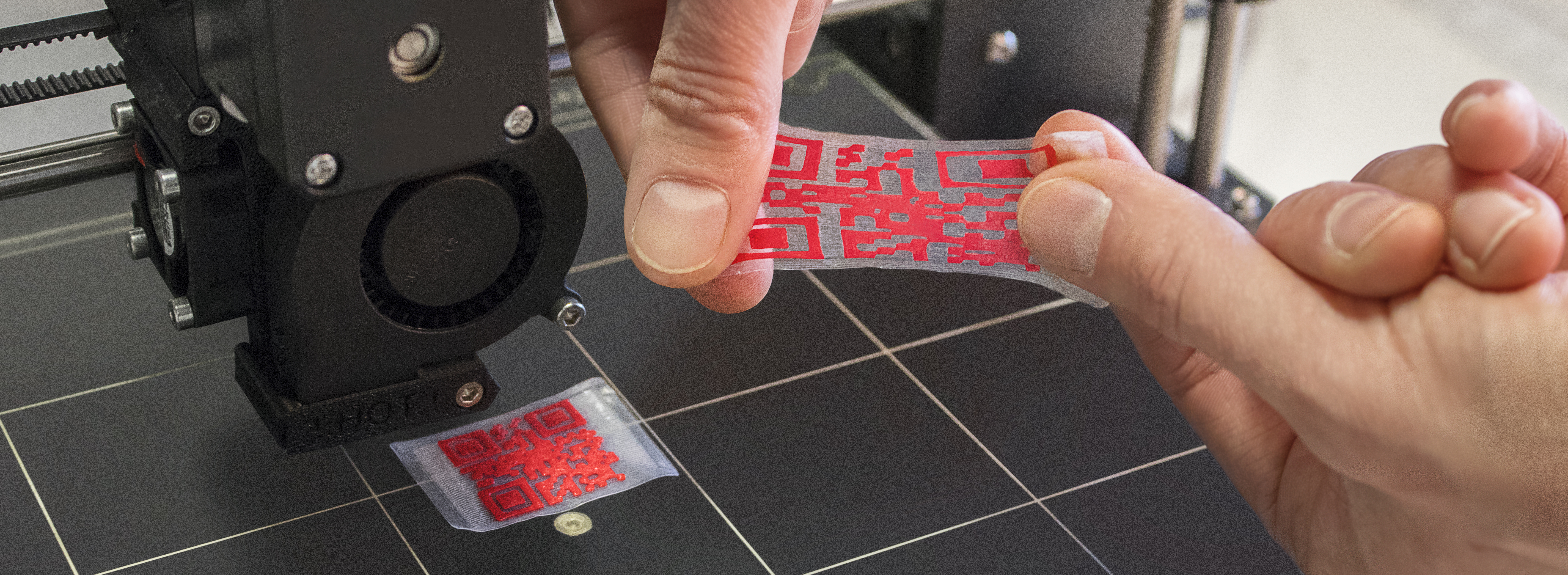Shape-memory QR codes
A new process for the additive manufacturing of QR codes with shape memory properties has been developed at the Fraunhofer Institute for Applied Polymer Research IAP in Potsdam. It is based on the 3D printing of shape memory polymers. The QR codes were mathematically examined at the Fraunhofer Institute for Industrial Mathematics ITWM in Kaiserslautern; the print quality and the shape memory effect are very good. QR codes can be produced that are very flat and light, which makes the technology perfect for labels, e.g. as a security device against product piracy. The high-tech polymers can be processed with commercially available 3D printers.

Shape memory polymers are smart materials. These plastics can retain a shape imposed on them for a certain period of time. As soon as the temperature increases, they switch “on demand”, returning almost completely to their original shape. Certificates of authenticity that provide product-related information are one possible application for shape memory polymers. These include QR codes developed by the Fraunhofer IAP using additive manufacturing. Once printed, the shape changes so that the QR code can no longer be read. The original shape of the polymer is restored only after it has been heated above the switching temperature, at which time the QR code can finally be read.
Can shape memory polymers be printed?
“In the past, the production of information carriers, like QR codes based on shape memory polymers, was complex and labor-intensive”, explains Dr. Thorsten Pretsch, head of the “Shape Memory Polymers” research group at the Fraunhofer IAP. “Therefore, we print the QR codes in 3D using a thermoplastic polyurethane, or TPU for short. This plastic is one of the most intensively studied shape memory polymers; however, little investigation has been done on using fused filament fabrication to process it as part of additive manufacturing. We have both produced the filament and optimized the printing process”, says Pretsch.
The research team used fused filament fabrication (FFF), a 3D process in which two filaments made of the smart plastic are melted in a dual extruder 3D printer and then pressed through fine nozzles. The desired object, here the QR code, is built up in layers. The scientists at the Fraunhofer IAP used an extrusion process to produce the required filaments from “pure” TPU and from TPU dyed with a pigment. The thermoplastic polyurethane was provided by Covestro Deutschland AG. Both the production of the filament and the optimization of the printing process were conducted within the framework of the High-Performance Center “Integration of Biological and Physical-Chemical Material Functions”.
How is shape memory produced?
In test series, a printed QR code was heated to 60 °C and deformed in various ways. Then the QR code was cooled down to -15 °C and unloaded. The deformed state remains in effect at room temperature until the QR code is reheated to 60 °C. This triggers the shape memory effect and the code almost completely returns to its original shape. As a benefit, the polymer’s switching temperature can be specifically set over a wide range of temperatures depending on the application.
Shape memory properties under scrutiny
As part of the Fraunhofer Cluster of Excellence “Programmable Materials” a research team at the Fraunhofer ITWM analyzed how well the QR codes returned to their original shape after the shape memory effect was triggered. They compared the print quality with the original digitally generated QR codes and mathematically evaluated the surface profiles of the code carriers recorded at the Fraunhofer IAP. “This novel method is an excellent tool for evaluating the print quality of QR codes. Our congruence analyses show that the QR codes are more than 87 percent identical to the original shape after the shape has been reset”, explains Dr. Sarah Staub from the Fraunhofer ITWM.
On the road to an industrial application
The new production process for QR codes has several advantages: extrusion of the polymer to produce the print filament is easy to master and only small amounts of material are required. Commercially available 3D printers can also be used to print layers that are less than 10 µm thick. These aspects, combined with the light weight of the QR codes, make the procedure of interest for industry, especially for the forgery-proof labeling of goods requiring protection from product piracy.
In order to increase the cost-effectiveness even further, researchers at the Fraunhofer IAP are working on shortening production times without compromising resolution.
Last modified: